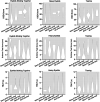Developing and validating a questionnaire to assess the symptoms of blepharitis accompanied by dry eye disease
- PMID: 37243742
- PMCID: PMC10543578
- DOI: 10.1007/s00417-023-06104-2
Developing and validating a questionnaire to assess the symptoms of blepharitis accompanied by dry eye disease
Abstract
Purpose: To propose additional items for established dry eye disease (DED) instruments that cover blepharitis-specific signs and symptoms and to determine the association between the clinical findings and subjective complaints.
Methods: Thirty-one patients with blepharitis and DED were prospectively included in the pretest period for selecting suitable questions. In the main phase of the study, the selected questions were then tested on 68 patients with blepharitis and DED and 20 controls without blepharitis or DED. Pearson's coefficient of correlation was calculated between the blepharitis-specific questions, tear break-up time (TBUT), the Schirmer test score, and the ocular surface disease index (OSDI) score; and the similarity between the blepharitis-specific questions, OSDI questions, and objective parameters for DED was assessed via hierarchical clustering. Furthermore, the discriminatory power of the blepharitis-specific questions was investigated with the receiver operating characteristic (ROC) curve.
Results: The additional question about heavy eyelids revealed a significant correlation with the OSDI score (r = 0.45, p < 0.001) and Schirmer score (r = - 0.32, p = 0.006). Cluster analysis demonstrated the similarity between the question about heavy eyelids and TBUT. In addition, the OSDI questionnaire had the highest discriminatory power in ROC analysis, and the OSDI score significantly correlated with the specific questions about eyelids sticking together (r = 0.47, p < 0.0001) and watery or teary eyes (r = 0.34, p = 0.003).
Conclusions: The blepharitis-specific additional questions were closely associated with objective parameters for DED. The question about heavy eyelids might be well suited for recording the symptoms of hyposecretory and hyperevaporative dry eye with blepharitis.
Keywords: Blepharitis; Dry eye disease; Ocular surface disease index.
© 2023. The Author(s).
Conflict of interest statement
The authors declare no competing interests.
Figures




Similar articles
-
Matrix Metalloproteinase 9 Testing in Dry Eye Disease Using a Commercially Available Point-of-Care Immunoassay.Ophthalmology. 2016 Nov;123(11):2300-2308. doi: 10.1016/j.ophtha.2016.07.028. Epub 2016 Sep 21. Ophthalmology. 2016. PMID: 27665213
-
Symptomatic dry eye disease among university students.Med Hypothesis Discov Innov Ophthalmol. 2023 Dec 31;12(2):70-77. doi: 10.51329/mehdiophthal1472. eCollection 2023 Summer. Med Hypothesis Discov Innov Ophthalmol. 2023. PMID: 38357613 Free PMC article.
-
Objective Signs <em>versus</em> Subjective Disease Index in Dry Eye Disease.J Coll Physicians Surg Pak. 2024 Jul;34(7):845-847. doi: 10.29271/jcpsp.2024.07.845. J Coll Physicians Surg Pak. 2024. PMID: 38978253
-
Dry Eye Disease: Early Recognition with Guidance on Management and Treatment for Primary Care Family Physicians.Ophthalmol Ther. 2020 Dec;9(4):877-888. doi: 10.1007/s40123-020-00308-z. Epub 2020 Oct 22. Ophthalmol Ther. 2020. PMID: 33090327 Free PMC article. Review.
-
Acupuncture for the management of dry eye disease.Front Med. 2022 Dec;16(6):975-983. doi: 10.1007/s11684-022-0923-4. Epub 2022 Sep 24. Front Med. 2022. PMID: 36152126
Cited by
-
Efficacy of 1% Povidone-Iodine in the Treatment of Anterior Blepharitis-Randomized Single-Center Controlled Trial.J Clin Med. 2024 Nov 28;13(23):7227. doi: 10.3390/jcm13237227. J Clin Med. 2024. PMID: 39685686 Free PMC article.
References
-
- Heiligenhaus A, Koch J, Kruse F, et al. Diagnosis and and differentiation of dry eye disorders. Der Ophthalmologe : Zeitschrift der Deutschen Ophthalmologischen Gesellschaft. 1995;92:6–11. - PubMed
MeSH terms
LinkOut - more resources
Full Text Sources

